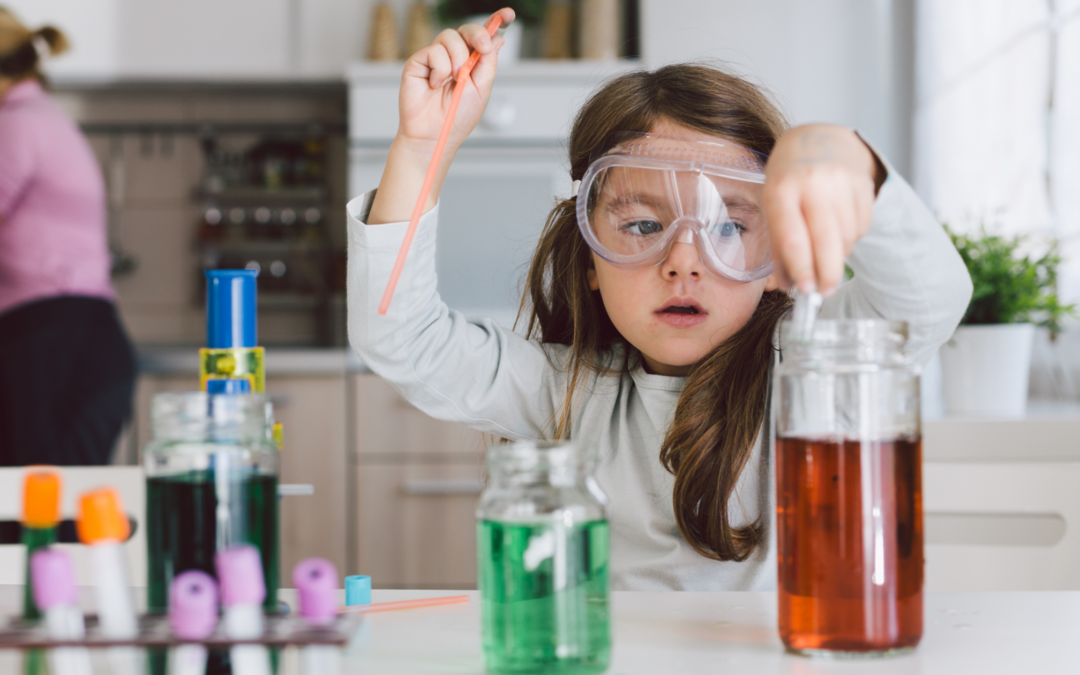10 Easy Summer Science Projects for Homeschoolers (Using Items You Already Have!)
Join the fun! Our 2025 Summer Science Fair is around the corner—start exploring with these exciting at-home experiments for grades 3–6.
Summer is a wonderful time of exploration, and many of us spend a few extra hours outside enjoying the natural world.
For homeschoolers, this change in our daily rhythm does not mean that learning stops. Instead, we find real-world applications for the principles we have been discovering in our classes and textbooks!
If you have a grade school student looking for some fun summer ideas, why not give these exciting science projects a try?
All of these projects can be completed with normal household items. Most are achievable in one afternoon—talk about quick and easy learning!
3rd to 4th Grade
Paper Plane Pilot Test
Help reinforce the principles of aerodynamics with nothing more than a few pieces of paper and a measuring tape!
Make several different kinds of paper planes—you can check out some folding methods here—and arrange testing conditions. (You can use a driveway, lawn, or anywhere with a long open space.)
Throw each plane with the same amount of force and technique. Measure how far each plane goes and write it on your experiment record page.
When you have the data from each test flight, review each design based on the forces of thrust, lift, weight, and drag. (You can find a diagram and read more about these forces here.)
Why do you think the winning plane went furthest? What might you modify about the design of the losing plane?
Plastic Bottle Rocket
Make your very own rocket with a plastic bottle, a cork, some duct tape, paper straws, and some baking soda and vinegar.
You can read full instructions and see a diagram here, but the basic idea is to tape four straws around the outside of the plastic bottle so that it can stand upside down without the cap touching the ground.
With your cork ready to go, put baking soda into the bottle, pour in some vinegar, and quickly plug the top with the cork. Set the bottle upside down, balancing on the straws, and wait for the rocket to launch!!
After cleaning up, review the reaction between baking soda and vinegar, and observe how carbon dioxide gas is released inside the bottle, building pressure until the rocket launches.
Treat Some Ants to Lunch
Study animal behavior by observing which foods ants like best!
Find an ant hill in an undisturbed area. Select at least four different kinds of food—try to make them as different as possible and perhaps relate them to the five tastes humans have (sweet, salty, sour, bitter). The more options, the better!
Take a small portion of each food item and make a little circle of food around the ant hill. Measure to ensure that each food station is equidistant from the ant hill.
Watch and wait! Check on the experiment frequently, and maybe take some pictures. (If you have a camera available, a timelapse video would also be a cool way to measure ant activity!) Count how many ants you see visiting each of the food stations.
Keep notes on your experiment log page. At the end of the day (or after a few hours) rank the foods in order of the ants most to least favorite! Why do you think the ants preferred their favorite food?
Tasty Salad Test
Learn about the way plants take up water through capillary action and taste some crazy salad at the same time!
You will need three cups or beakers of water, some sugar, some salt, some natural food dye in blue or red (you can use beet juice if you would like to avoid dyes entirely), and some romaine lettuce. (The fresher the lettuce, the better—see if you can get some from a local garden.)
Fill the three cups with water. In the first cup, dissolve a few teaspoons of sugar. Label the cup “sugar”. In the second cup, dissolve a few teaspoons of salt. Label the cup “salt”. In the third cup, add the food dye. Label the cup “food dye”.
Place one lettuce leaf in each cup, standing upright like a cut flower. Make sure the bottom of the leaf is freshly cut so it can absorb the mixture.
After about 5 or 6 hours, check on the leaves. Taste them—which ones taste different? Which ones look different?
Take pictures and write your findings in your logbook page.
5th to 6th Grade
Balloon Vehicle
Use the force of air to power a model car!
Work on your engineering design skills by crafting a “car” from a piece of cardboard or a plastic bottle, some wooden skewers, plastic bottle caps, a balloon, plastic straws, and some tape.
You can read full instructions with diagrams here, but essentially, you can use whatever materials you have to hand to create a basic vehicle with a flat body, four wheels, and two axles. You will blow up the balloon without tying it, tape it to the body of the car, and let the balloon release its potential energy.
Watch your vehicle fly along the track! You can also involve the whole family and try different designs in your ballon vehicle race.
Make a Bouncing Egg
Learn about chemical reactions by dissolving the calcium carbonate of an egg shell in vinegar. (This reaction might take longer than a day, so maybe we are stretching a point by including it in the list. However, you can see results within a few hours, or leave the experiment overnight and enjoy the results the next day.)
You will need one raw egg, one hard-boiled egg, several cups of white vinegar, two clear glass jars or cups large enough to easily fit an egg, and a spoon.
Fill the two jars with vinegar. Place the raw egg into one jar and the hard-boiled egg into the other. Label each jar so you will not forget which is which.
Leave the eggs for several hours or overnight. You should start to see a kind of foam or scum forming on the surface of the vinegar. This is the dissolving eggshell! Pour out the vinegar and replace it with fresh vinegar, being careful not to disturb the eggs.
The next day, check on the eggs. The eggshells should have entirely dissolved, leaving only the membrane behind. (You can leave them for longer if they are not yet dissolved.)
Remove the eggs from the vinegar. Observe the differences between the raw and hard boiled eggs. What do they feel like? Look like?
In a place where you don’t mind about mess (maybe outside on a deck you can hose down), try bouncing your shell-less eggs! They should be bouncy and flexible. Note all results in your experiment log.
Make Casien Plastic from Milk
Did you know you can make plastic out of milk? Until the 1940s, people used to use milk-produced polymers for items like buttons or beads. Try this fun experiment with your kitchen equipment!
You will need 1 cup of low-fat milk, 4 teaspoons of white vinegar, a saucepan, paper towels, spoons, a candy thermometer, paper towels, a cookie sheet, a heat-resistant container, and a stovetop. Note that this is enough to have one try at making plastic, so we recommend having several rounds of this on hand. You may want to try with different variables to see if that makes a difference in your experiment.
Heat the cup of milk in the saucepan until it is steaming (measure and note the temperature with your thermometer). Pour the milk into a heat-resistant container (a large mug might work) and add the 4 tablespoons of vinegar. The milk should separate.
Mix the curdled milk slowly a few times and wait for the mixture to cool enough so that you can touch it.
Stack several layers of paper towels on top of the cookie sheet. Using a spoon, scoop out the solid part of the mixture onto the paper towels, leaving the watery bit behind.
Squeeze out all the remaining liquid from the curds with the paper towels.
This goopy stuff is casein plastic! Knead it until it has a moldable consistency. You can make a sculpture or a small item from your plastic and leave it to dry!
Dissect a Flower
For many of us, flowering plants are a normal part of our environment, but do you really know what goes on inside them? Can you name the parts of a flower?
For this project, you will need fresh flowers (preferably large ones like lilies that are easy to cut and observe), scissors, an art knife or safety x-acto knife, a magnifying glass or microscope, and paper and pencil or a camera. You may also wish to read a guide to flower anatomy, like this one, so you know what to identify before you start.
First, identify your flower type using information online or in a flower identification book. Once you know what you are dealing with, take a picture or make a drawing of the flower before you dissect it.
Remove the flower petals, counting them and noticing how they attach to the flower. You can use a flower identification guide to find out what kind of formation this is—funnel, salverform, rosette, star, saucer?
Next, look at the stamen and see if you can see any pollen in the flower. Remove these and look at the base of the flower. Once you have observed and taken notes, cut open the stem all the way up through the calyx—try to get it in two even halves without hacking too much. What do you see? Get out your microscope and write down all the parts of flower anatomy you can identify!
Take pictures as you go, and keep them for your logbook.
Conclusion
Summer is the perfect season to turn curiosity into discovery. With just a few household items, your child can explore the wonders of God’s creation, reinforce key science concepts, and build confidence through hands-on learning. Whether it’s testing paper airplanes, launching bottle rockets, or dissecting flowers, these projects are more than just educational—they’re fun, memorable, and meaningful.
And when you’re ready to take it to the next level, join us for the Homeschool Connections Grade School Science Fair! It’s a joyful opportunity for your child to showcase their creativity, connect with other Catholic homeschoolers, and maybe even win a prize.
We can’t wait to celebrate your budding scientist’s hard work!






